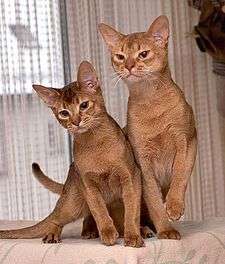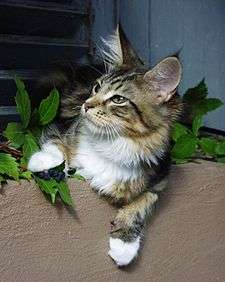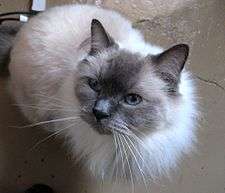Puppy cat

Puppy cat (or puppy-like cat, dog-like cat, etc) is a term used to refer to specific breeds of domestic cats that feature unusual behavioral tendencies that are reminiscent of young domestic dogs, those tendencies within the general, broad scope of feline behavior being enhanced through selective breeding. Specific examples include the tendency to follow owners and other people around from room to room, the desire to receive frequent moments of physical affection such as being held and petted, a lack of aggression toward some fellow animals (such as other felines), and a general placid nature. "Puppy cat" and related terms have been used to label breeds such as the 'Abyssinian',[1][2] 'Burmese',[1][2] 'Maine Coon',[3][4] 'Manx',[2][5] and 'Ragdoll'.[6][7] While these attributes are found desirable for owners interacting with their cats, problems can occur when the felines are exposed to dogs and strange people, with the cats possibly being too trusting and too friendly for their own good.[6]
The notion of cats that act, sound and look like, and otherwise are highly similar to dogs has been explored in several fictional works in modern popular culture, including the animated series Bee and PuppyCat. Viral images of cats attempting to infiltrate groups of dogs and other such things are also a part of internet humor alongside 'lolcats'.
Example breeds
Broad cultural assumptions state that pet cats display particular distance from human beings and show a lack of attentive affection when compared to pet dogs.[1] These assumptions about cat behavior have numerous complications. In general terms, the animals will have individual characteristics based on their environment, particularly their past interactions with people.
The feline temperament is particularly malleable to a wide set of environmental factors, especially sudden stresses. A notable case from a group of dangerous floods in Canvey Island demonstrated that the cats showed behaviors of psychological 'shock' akin to human struggles, the felines receiving drug-based therapies as well.[1] Well-raised kittens frequently demonstrate affection towards humans and a pleasant, docile nature regardless of pedigree. These broad traits are not specific to any particular breed, as the upbringing of the animal is an important factor. Positive interaction with humans in the first few months of life is particularly vital.[8]
Most feline pets in the United States are considered to be domestic short-haired cats, a catch-all term for those with mixed or otherwise unclear ancestries but having related appearances. Several of those cats, or those of the standardized American Shorthair breed, will respond differently to others despite looking very similar, displaying dog-like or otherwise unexpected tendencies. Besides breed-based generalizations, a particular cat's behavior can be assessed by its restraint in using claws during play, its tendency to follow people, and its appreciation of close and frequent human contact.
Abyssinian

Abyssinian cats are known for demanding a lot of attention and showing a sense of depression if left alone too often. The closeness to their owners cause some of them to respond positively to feline leash-training. Unlike other breeds, the cats often show interest in water rather than a fear of it. A frequently active breed, Abyssinians' will often climb upon their owners and perch upon their bodies to see. They also tend to welcome the company of friendly-minded dogs.[9][2]
They are one of the oldest known breeds found in recorded history, with archaeologists discovering evidence of Abyssinian-type cats living in ancient Egyptian locations thousands of years ago. These felines were unknown in nations such as the U.S. until the 21st century, but they became increasingly popular as time went on, with two Abyssinians playing the titular role in the 1978 film The Cat From Outer Space. The animals feature a distinctive 'ticked' coat, in which individual hairs vary in color yet blur into a general appearance in normal view.[9]
Veterinarian Joan O. Joshua has written that the "dog-like attachment to the owners" of Abyssinians causes "greater dependence on human contacts". This stands in contrast to the mere "tolerant acceptance of human company" based around "comforts" that multiple other breeds display.[1] With their interest in playing with their owners combined with their curious intelligence, Abyssinians are nicknamed the "Clowns of the Cat Kingdom."[9]
Burmese
The Burmese breed typically displays the dog-like attachment seen in Abyssinians.[1][2] They both also share the combination of high intelligence and tendency to stay close that makes training them to be on a leash practical.[10][5] The Burmese are persistently more vocal than other breeds and express interest in playing games akin to puppies. American and British breeders have developed distinctly different standards for the Burmese, a situation that's unusual among pedigreed cats, and the British type has attracted the colloquial title of 'European Burmese'.
Maine Coon

One of the largest cat breeds in existence, the origin of the Maine Coon has been shrouded in a great deal of myths and legends. The felines are, in the words of Academy of Veterinary Nutrition Technicians President Kara Burns and Dr. Lori Renda-Francis, "often referred to as 'dog like'." This occurs not just in terms of their size and stature but also because of the cats' usually pleasant mannerisms and tendency to closely follow their owners, and obey them. Maine Coon cats also are often trainable given their intelligence and affectionate nature. The felines have large and silky coats yet grooming is made easier given their desire to be frequently handled.[3][4]
The combination of the cats' size and treatment has given rise to their nickname as 'gentle giants'. Adults tend to weigh around nine to sixteen pounds if female and thirteen to eighteen pounds if male; they may be initially mistaken for bobcats and other wild animals. In 2015, the Cat Fanciers' Association stated that Maine Coons were the third most popular breed in the U.S. The organization has stated that the dog-like felines offer "hours of enjoyment with their antics" while acting "intrusive" since "[w]ithout question" the cats "want to be [a] part of everything".[3][11]
Manx
In terms of the Manx breed, many of these cats show behaviors like that of puppies, such as coming when their owners whistle or call their names. The animals are known for jumping and climbing about obstacles as well as burying things, even collecting and burying toys at times. Manx felines will also display strong affection generally. Dr. David Taylor, writer and founder of the founder of International Zoo Veterinary Group, has labeled the breed as "positively dog-like".[2][5]
Ragdoll
Originating from the southern California area in the United States, the Ragdoll breed gained its name by the animals' tendency to go limp when picked up as well as for their general tendencies to rest in that kind of bent position. The breed is known for how the cats usually display a calm, relaxed temperament, with the animals often seeking physical affection from owners and following owners around. The felines will sometime even play games such as 'fetch' given their love for socializing-type activities.[6][7]
Ann Baker, a Persian cat breeder, developed the Ragdoll in the 1960s starting with the offspring of a domestic long-haired white cat named Josephine, selecting for positive temperaments, pleasing looks, and non-matting fur. The Cat Fanciers Association recognized the breed in 1993 in the "miscellaneous" class. Physically, the cats generally have light-colored coats with Siamese-like points, with darker edges in areas such as the cats' paws and ears. Male ragdolls can become physically quite large, going up to around twenty pounds, even while still maintaining a general sort of playfulness well into adulthood. Since members of the breed are prone to be overly trusting, owners must exercise caution when bringing the cats outdoors. However, the felines generally interact well with children, seniors, and other pets.[6][7]
In fictional media
The animated series Catscratch depicts the adventures of three talking animals that, while being cats, display both human-like and dog-like behaviors while having various mishaps. In the particular episode Off the Leash, the cat Waffle runs away from home and manages to hang out with a group of canines for a time, with them baffled at a creature neither distinctly cat nor dog, and soon encounters a dog-catcher. Created by Doug TenNapel, who has also worked on Adventure Time and other cartoons, the program was broadcast from 2005 to 2007 on Nickelodeon.
The ongoing cartoon program Bee and PuppyCat features as a title character a magical being of unknown origin that appears and acts like a cat-dog hybrid. First airing in August 2013 on YouTube,[12] Natasha Allegri created the web series as a personal project with influences from Japanese cartoons such as Sailor Moon. The series is produced by Frederator Studios. Initial episodes proved popular enough for the series' Kickstarter project to ultimately earn more than $870,000.[13]
See also
- Bee and PuppyCat
- Cat intelligence
- Cat behavior
- Cat communication
- Dog behavior
- Dog–cat relationship
- Human interaction with cats
References
- 1 2 3 4 5 6 Joshua, Joan O. (2013). The Clinical Aspects of Some Diseases of Cats. Elsevier. pp. 1, 23–24. ISBN 9781483226002.
- 1 2 3 4 5 6 "Top Three Dog-Like Cat Breeds". Pet MD. Retrieved September 11, 2016.
- 1 2 3 "Maine Coon Cat". Cat Fanciers' Association. Retrieved September 11, 2016.
- 1 2 Kara Burns; Lori Renda-Franci (2014). Textbook for the Veterinary Assistant. John Wiley & Sons. ISBN 9781118813768.
- 1 2 3 Taylor, David (2011). The Complete Contented Cat. David & Charles. pp. 22, 106. ISBN 9780715336410.
- 1 2 3 4 Benjamin L. Hart; Lynette A. Hart (2013). Your Ideal Cat: Insights Into Breed and Gender Differences in Cat Behavior. Purdue University Press. pp. 99–101. ISBN 9781557536488.
- 1 2 3 "Ragdoll". VCA Animal Hospitals. Retrieved September 11, 2016.
- ↑ Becker, Mikkel (January 29, 2013). "Your Guide to Socializing a Kitten". vetstreet.com. Retrieved September 11, 2016.
- 1 2 3 "Abyssinian". VCA Animal Hospitals. Retrieved September 11, 2016.
- ↑ O'Flynn, Justine (1997). Guide to Owning a Burmese Cat. T.F.H. Publications. pp. 11–13. ISBN 9780793821693.
- ↑ Fawcett, Kirstin (March 11, 2016). "12 Huge Facts About Maine Coons". mentalfloss.com. Retrieved September 9, 2016.
- ↑ Wellen, Brianna. "Bee and PuppyCat is as adorable and bizarre as ever". Chicago Reader. Retrieved September 10, 2016.
- ↑ Ohanesian, Liz (December 1, 2014). "Bee & PuppyCat, the Rare Cartoon About an Adult Woman". LA Weekly. Retrieved September 9, 2016.
